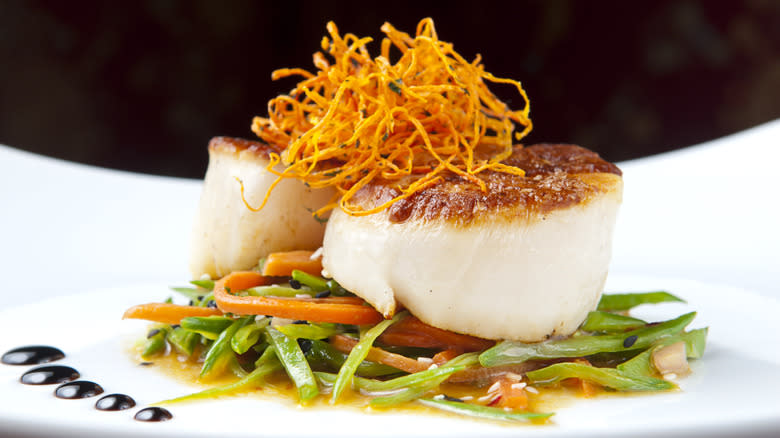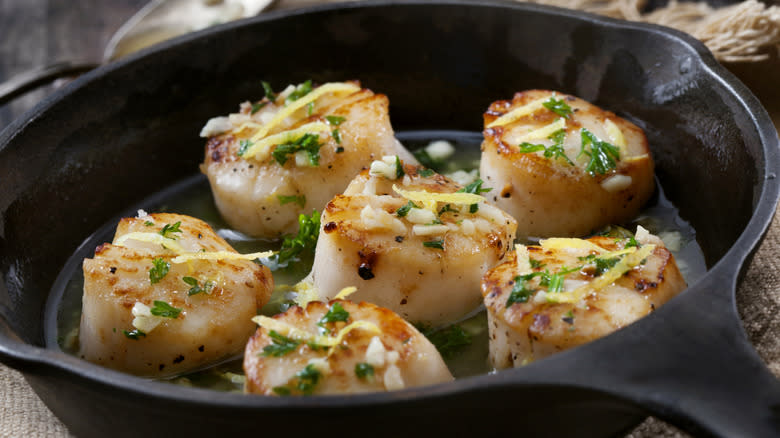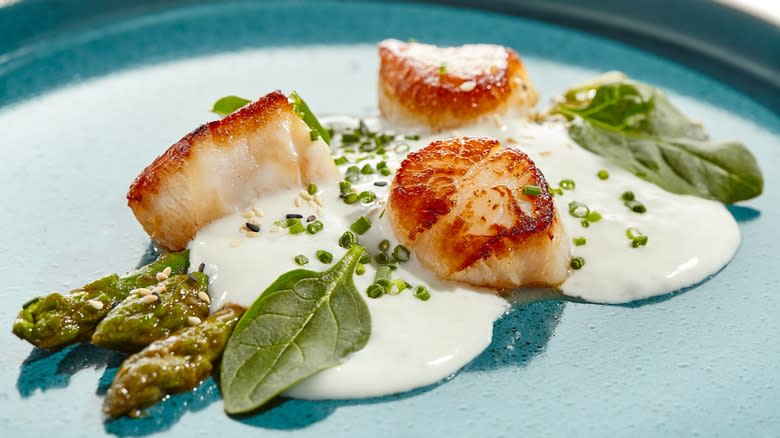For Perfectly Seared Scallops, You Need Both Oil And Butter

When searing any dish in a skillet, using butter is a safe bet. From hearty steaks to French toast, butter helps the searing process and gives your food an attractive appearance. Scallops are no different. The sweet-tasting and tender mollusks pair well with butter and only need a few additional ingredients to become an impressive dish.
Some home chefs may be tempted to throw some butter in with their scallops and call it a day, but the order of operations is significant for this dish. Other additions, while lesser-known, are also essential. Butter is good for flavor and color, but what scallops need at the beginning of the process is cooking oil. A best practice for any pan-seared scallops is to first sear the meat with a neutral oil before moving onto butter later in the process. Oil is essential to creating that aesthetically pleasing crust made when the scallop hits the pan -- but butter takes the whole dish to the next level.
Read more: 13 Tips To Make Your Shrimp Taste So Much Better
Pan-Searing Scallops In Oil, Then Finishing With Butter

Before oil can do its work and create a crispy outer layer on your scallops, the kitchen must be prepped. Oil can only do its job if the pan is piping hot. Because of this, using a stainless steel skillet is ideal. Nonstick pans don't have the proper texture for transforming scallops into golden brown delights. Next, place a minimal layer of oil at the bottom, and only when the pan is hot enough. Add the scallops at this point, and keep an eye on them; you'll know when the scallops are ready to be flipped when the pan naturally releases them.
Then, add the butter. This ingredient is best used for basting: Spoon the butter over the cooking scallops so it absorbs fully. This method is so simple that even total beginners can learn it, but be sure to keep the scallops from lingering too long in the pan. Once flipped, they can be quite easy to overcook and become unappetizing if they do. Once you've mastered these skills, scallops might just become one of your favorite weeknight dishes. You'll also understand the magic oil and butter can combine to create in the hands of a knowledgeable chef.
Tips For Pan-Searing Scallops

Combining oil and butter is the key to great scallops, but these two ingredients can only work their magic in the right environment. This environment's quality comes down to moisture. Scallops can generally be purchased in one of two ways: wet and dry. Wet scallops are, as you might expect, scallops packaged with water. This approach makes achieving a nice crust on your stovetop scallops more difficult. That's why you should keep an eye out for the second packaging option: dry-packed scallops. This dryness makes the difference between a satisfying sear and a lackluster result.
How important is keeping an eye out for errant moisture? Critical -- but don't take our word for it. "I always put [scallops] on a paper towel for a second," Chef Michael Symon explained on his personal TikTok account, "just to make sure any moisture that is on the scallop is gone." Home chefs should also ensure that they do not overcrowd the pan. That is a typical beginner's mistake that often causes the scallops to steam instead of sear.
The final touch for any good scallop dish is some added acidity. Lemon juice is a prime addition; because scallops have a slightly sweet taste, citrus balances them out. Seasonings are usually dealer's choice when it comes to this dish, but anything that goes well with butter is a solid decision.
Read the original article on Daily Meal.

